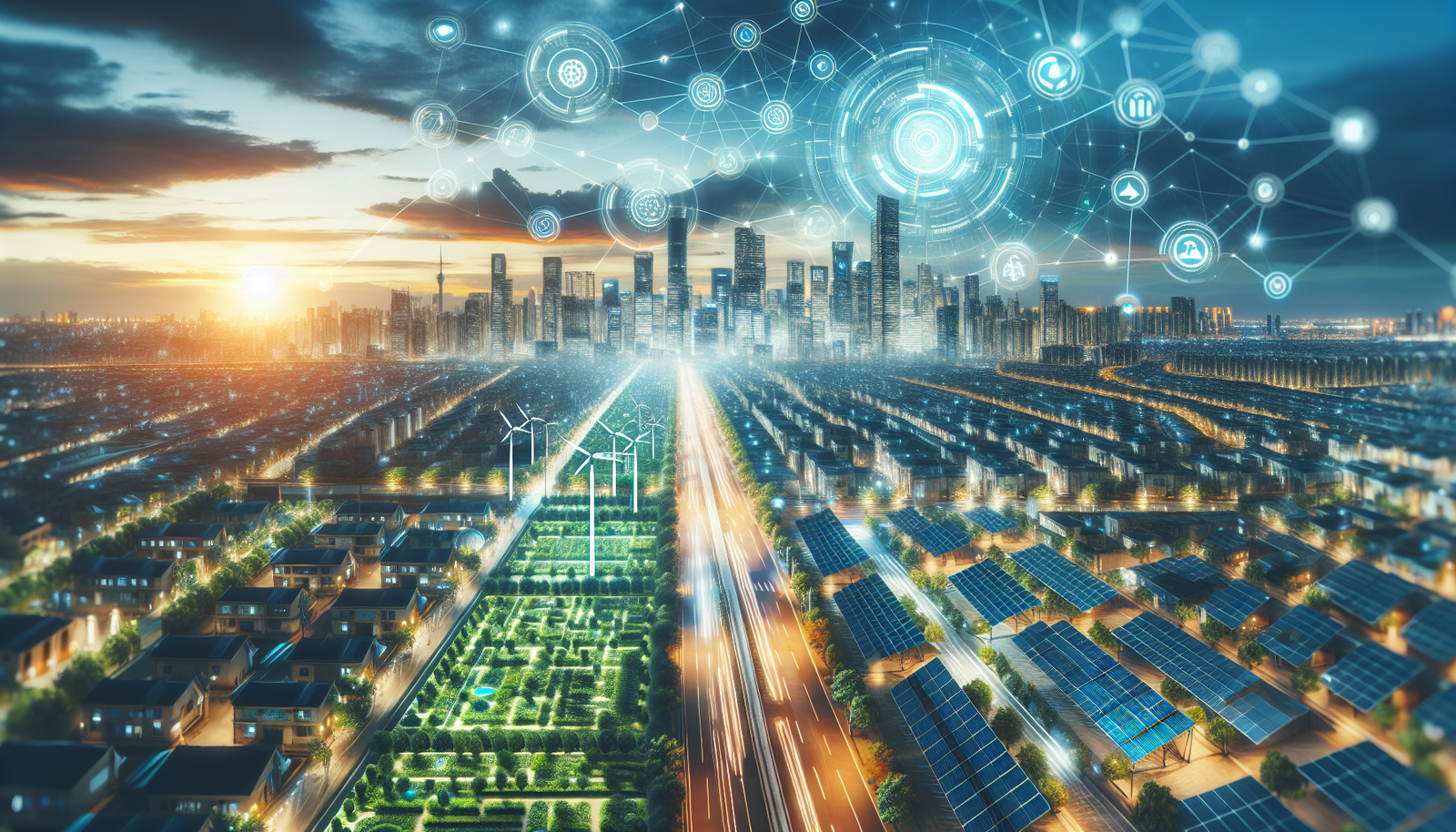AI in Resource Management
Artificial Intelligence (AI) plays a pivotal role in transforming resource management, enabling industries to optimize the use of natural resources efficiently. By leveraging AI algorithms, companies can monitor and analyze vast amounts of data in real-time, facilitating informed decisions that significantly reduce resource waste. For instance, in agriculture, AI-driven systems can predict weather patterns, assess soil health, and recommend optimal planting times, ensuring that water and fertilizers are used judiciously.
One of the critical applications of AI in resource management is in the energy sector. AI technologies can analyze consumption patterns and forecast demand, allowing for better grid management and reducing energy wastage. Smart grids equipped with AI can dynamically adjust energy distribution based on real-time data, ensuring that energy is used more efficiently. This not only helps in reducing the carbon footprint but also in lowering operational costs for energy providers.
Furthermore, AI facilitates efficient waste management practices by predicting waste generation trends and optimizing collection routes. For example, AI-powered waste management systems can use data from sensors to determine the fill levels of dumpsters, thereby optimizing pickup schedules and routes. This not only minimizes fuel consumption and emissions from waste collection vehicles but also enhances the overall efficiency of waste management operations.
| Industry | AI Application | Impact |
|---|---|---|
| Agriculture | Predictive Analytics | Reduced Water and Fertilizer Use |
| Energy | Smart Grids | Lower Energy Wastage |
| Waste Management | Route Optimization | Reduced Emissions |
Optimizing Supply Chains with AI
Artificial Intelligence (AI) plays a pivotal role in transforming supply chains to become more sustainable and efficient. By leveraging AI technologies, companies can optimize every aspect of their supply chains, from sourcing raw materials to delivering finished products. This optimization not only enhances the overall efficiency but also significantly reduces the environmental impact associated with traditional supply chain operations.
One key area where AI excels is in demand forecasting. By analyzing historical data and identifying patterns, AI algorithms can accurately predict future demand for products. This allows companies to minimize overproduction, thereby reducing waste. Additionally, AI can assist in optimizing inventory levels, ensuring that resources are utilized efficiently. The implementation of AI-driven demand forecasting can lead to a reduction in waste by up to 30%.
AI also contributes to sustainable supply chains through route optimization. By analyzing various data points such as traffic conditions, fuel consumption, and delivery schedules, AI can determine the most efficient delivery routes. This not only reduces fuel usage and emissions but also cuts down on delivery times. In fact, companies implementing AI-powered route optimization have reported a decrease in fuel consumption by 15% on average.
Furthermore, AI enhances supplier selection and management. By evaluating suppliers based on sustainability criteria, AI helps companies choose partners who prioritize eco-friendly practices. This collaboration fosters a more sustainable supply chain network. Below is an illustrative table showcasing the potential impact of AI on various supply chain components:
| Component | Impact of AI |
|---|---|
| Demand Forecasting | Reduces waste by accurately predicting demand |
| Route Optimization | Decreases fuel consumption and emissions |
| Supplier Management | Promotes selection of eco-friendly partners |
AI-Driven Waste Reduction
Artificial Intelligence (AI) has the potential to significantly reduce waste across various industries by optimizing processes and enhancing decision-making. Through advanced algorithms and data analysis, AI systems can identify patterns and inefficiencies in production lines, helping companies to minimize waste generation. For instance, in the manufacturing sector, AI can predict equipment failures and maintenance needs, thereby preventing unexpected downtimes and reducing the amount of defective products.
Moreover, AI technologies are increasingly being used in the food industry to address the enormous problem of food waste. By utilizing machine learning algorithms, businesses can better forecast demand, manage inventory, and optimize supply chains. This ensures that food is distributed more efficiently, reducing spoilage and waste. Below is a table illustrating the potential impact of AI on food waste reduction:
| AI Technology | Impact on Waste Reduction |
|---|---|
| Demand Forecasting | 20% reduction in overproduction |
| Supply Chain Optimization | 15% decrease in spoilage |
| Inventory Management | 25% reduction in expired products |
Another significant area where AI contributes to waste reduction is in recycling and waste management. AI-powered robots and sorting systems can accurately separate recyclable materials from general waste, improving recycling rates and reducing contamination. These systems can quickly adapt to different types of materials, making the recycling process more efficient. The use of AI in waste management not only helps in minimizing the environmental footprint but also maximizes the recovery of valuable resources.
In summary, AI-driven waste reduction initiatives offer promising solutions to one of the most critical environmental challenges. By harnessing the power of AI, industries can transition towards more sustainable practices, ultimately contributing to the global goal of sustainable consumption and production. The integration of AI in waste management systems is not only beneficial for the environment but also economically advantageous for businesses striving to reduce operational costs and improve efficiency.
Energy Efficiency and AI
Artificial Intelligence (AI) is playing a pivotal role in enhancing energy efficiency, which is a crucial component of sustainable production. By leveraging AI technologies, industries can optimize energy consumption, thereby reducing their environmental footprint. AI algorithms are capable of analyzing vast amounts of data to identify patterns and inefficiencies in energy use. This analysis can lead to actionable insights that help industries reduce energy wastage and improve overall efficiency.
One of the most significant applications of AI in energy efficiency is in the smart grid systems. These systems use AI to manage the distribution of electricity more effectively, ensuring that energy supply meets demand in the most efficient way possible. For instance, AI can predict peak demand times and optimize energy distribution accordingly, minimizing waste and reducing the need for additional energy production. This not only conserves resources but also saves costs for both providers and consumers.
- Predictive Maintenance: AI can forecast when equipment is likely to fail or operate inefficiently, allowing for timely maintenance that prevents energy loss.
- Process Optimization: By evaluating processes in real-time, AI can suggest modifications that reduce energy consumption without sacrificing performance.
- Energy Audits: AI-driven energy audits provide detailed insights into energy use patterns, pinpointing areas where efficiency improvements are most needed.
Moreover, AI’s ability to enhance energy efficiency extends beyond industrial applications. In residential settings, AI-powered devices and applications can monitor energy usage and provide recommendations on how to reduce consumption. These technologies can lead to significant reductions in household energy use, contributing to broader environmental sustainability goals.
| Application | Benefit |
|---|---|
| Smart Grid Systems | Optimizes energy distribution, reduces waste |
| Predictive Maintenance | Prevents energy loss through timely maintenance |
| Process Optimization | Enhances efficiency without affecting performance |
| Energy Audits | Identifies areas for efficiency improvements |
Sustainable Product Design with AI
Artificial Intelligence (AI) is reshaping the landscape of sustainable product design by introducing innovative approaches that enhance efficiency and reduce environmental impact. In the realm of sustainable product design, AI leverages vast datasets to identify materials and processes that minimize ecological footprints. This technology aids designers in selecting eco-friendly materials and optimizing product lifecycles, resulting in reduced waste and energy consumption.
One of the significant contributions of AI in sustainable design is its ability to simulate and analyze multiple design scenarios quickly. This capability allows for the exploration of various sustainable design strategies without the need for physical prototypes, thus saving resources. Moreover, AI-driven algorithms can suggest design modifications that can lead to increased durability and recyclability of products. The use of AI in design software helps in creating products that not only meet consumer demands but also adhere to environmental standards.
The table below illustrates the potential environmental benefits of incorporating AI in product design:
| AI-Driven Design Aspect | Environmental Benefit |
|---|---|
| Material Optimization | Reduces raw material usage by up to 30% |
| Efficient Prototyping | Decreases waste from prototype production by 25% |
| Lifecycle Analysis | Enhances product lifespan by 20% |
AI also facilitates the incorporation of circular economy principles in product design. By predicting wear and tear, AI can guide the design of products that are easier to repair, upgrade, or recycle. This approach not only extends the useful life of products but also supports the creation of closed-loop systems where materials are continually reused, minimizing the need for virgin resources. In summary, the integration of AI in sustainable product design is a powerful tool that helps industries transition towards more sustainable and responsible production methodologies.
AI in Circular Economy
Artificial Intelligence (AI) is playing a pivotal role in transforming the circular economy, a model that emphasizes sustainable production and consumption by maximizing resource efficiency and minimizing waste. AI technologies are now being employed to streamline and enhance various processes within this model, enabling businesses to reduce their environmental footprint and promote sustainability.
One of the primary ways AI contributes to the circular economy is through enhanced resource management. By leveraging machine learning algorithms, companies can predict supply and demand patterns more accurately, ensuring that resources are utilized optimally. AI systems can analyze vast datasets to identify trends and anomalies, allowing for real-time adjustments in production processes. This not only reduces waste but also ensures that resources are allocated where they are most needed, minimizing environmental impact.
AI also facilitates the automation of recycling processes. Advanced AI-driven sorting systems are now capable of identifying and categorizing waste materials with high precision. This leads to more efficient recycling operations, reducing the amount of waste that ends up in landfills. For instance, AI-powered robots can distinguish between different types of plastics and metals, ensuring that each material is processed appropriately. This level of precision was previously unattainable with manual sorting methods.
Moreover, AI is instrumental in enhancing product lifecycle management. By analyzing data from the entire lifecycle of a product—from design and manufacturing to disposal—AI helps companies design products that are easier to recycle and more durable. This shift not only conserves resources but also extends the lifespan of products, aligning with the principles of the circular economy.
AI and Eco-Friendly Packaging
The integration of Artificial Intelligence (AI) into eco-friendly packaging solutions presents transformative opportunities for reducing environmental impact. AI technologies can optimize packaging design by analyzing vast datasets to identify sustainable materials and efficient designs that minimize waste. By employing machine learning algorithms, companies can simulate and test various packaging configurations to determine the most effective solutions that maintain product integrity while reducing material usage.
Moreover, AI-driven analysis can facilitate the transition to biodegradable and recyclable materials. By evaluating the environmental footprint of different packaging options, AI can guide manufacturers towards materials that offer minimal ecological impact. This shift not only helps in reducing the carbon footprint but also aligns with global sustainability goals. Companies leveraging AI in packaging are seeing a significant reduction in waste generation, as they can predict and eliminate excessive packaging components.
AI also contributes to the efficiency of packaging processes through automation and robotics. Automated systems, powered by AI, can enhance the precision and speed of packaging lines, leading to less resource consumption and lower energy use. This efficiency is crucial for meeting the growing demand for sustainable packaging solutions without compromising on productivity. Implementing AI in packaging operations has shown reductions in energy consumption by up to 30% in some industries, highlighting the potential for energy savings.
- AI optimizes the use of sustainable materials.
- Reduces waste through efficient design and automation.
- Enhances the recyclability and biodegradability of packaging.
In summary, AI offers innovative solutions for eco-friendly packaging by enabling smarter resource management, enhancing material selection, and streamlining manufacturing processes. As industries continue to prioritize sustainability, AI’s role in packaging is expected to expand, driving further advancements in reducing environmental impact.
AI-Powered Consumer Behavior Analysis
Artificial Intelligence (AI) has been making significant strides in analyzing consumer behavior, offering unprecedented insights into sustainable consumption patterns. By leveraging machine learning algorithms and big data analytics, businesses can now better understand consumer preferences and predict future trends. This ability to analyze vast amounts of data enables companies to tailor their products and services to meet the growing demand for eco-friendly options.
One of the key ways AI aids in consumer behavior analysis is through sentiment analysis and social media monitoring. By analyzing data from platforms like Twitter, Instagram, and Facebook, AI tools can gauge public sentiment about sustainable products and identify emerging trends. This information is invaluable for companies looking to align their offerings with consumer expectations. Additionally, AI-driven recommendation systems can suggest sustainable products to consumers based on their browsing and purchase history, thereby promoting eco-friendly choices.
AI also plays a crucial role in segmenting the market based on consumer behavior. By employing clustering algorithms, companies can identify distinct groups within their customer base that prioritize sustainability. This segmentation allows businesses to develop targeted marketing strategies that resonate with environmentally conscious consumers. Furthermore, AI-driven analytics can help track the effectiveness of these strategies, enabling continuous improvement.
Incorporating AI in consumer behavior analysis not only helps businesses reduce their environmental impact but also enhances their competitiveness in the market. As consumers become more aware of their ecological footprint, companies that leverage AI to promote sustainable consumption are likely to gain a significant advantage. Overall, AI-powered consumer behavior analysis is a powerful tool for driving sustainable consumption and production practices across various industries.
AI in Carbon Footprint Reduction
Artificial Intelligence (AI) plays a pivotal role in reducing carbon footprints across various industries. By leveraging data-driven insights and predictive analytics, AI can identify inefficiencies in energy consumption and resource use, enabling organizations to implement targeted strategies for carbon reduction. For instance, in the manufacturing sector, AI algorithms can optimize production schedules and maintenance routines to minimize energy usage and lower emissions. In addition, AI-powered systems can monitor and control industrial processes in real-time, ensuring that energy consumption aligns with sustainability objectives.
Transportation and logistics are also key areas where AI contributes to carbon footprint reduction. AI technologies can optimize routing and logistics planning, leading to significant reductions in fuel consumption and emissions. Autonomous vehicles equipped with AI can further enhance efficiency by reducing idle times and improving traffic flow. Moreover, AI can assist in the transition to electric vehicles by forecasting energy demand and optimizing charging station placement, thus facilitating a shift towards more sustainable modes of transportation.
The integration of AI in energy management systems is another impactful application for carbon reduction. By implementing smart grids and AI-driven demand response systems, energy providers can better balance supply and demand, reducing reliance on fossil fuels. AI algorithms can predict energy demand patterns and adjust supply accordingly, leading to more efficient use of renewable energy sources. This not only lowers carbon emissions but also supports the broader adoption of green energy solutions.
Furthermore, AI can enhance carbon footprint reduction through improved waste management practices. AI-driven sorting and recycling technologies can increase the efficiency of material recovery, reducing the need for raw material extraction and the associated emissions. By analyzing waste generation patterns, AI can also provide insights into reducing waste at the source, promoting sustainable consumption habits. Overall, the integration of AI in carbon footprint reduction efforts offers a promising pathway towards achieving global sustainability goals and mitigating the impacts of climate change.
AI and Sustainable Agriculture
Artificial Intelligence (AI) is playing a transformative role in advancing sustainable agriculture practices, ensuring that food production meets the needs of the present without compromising the ability of future generations to meet their own needs. By leveraging AI technologies, farmers can optimize crop yields, reduce resource usage, and minimize environmental impact. AI-driven precision agriculture enables the monitoring of crop health through satellite imagery and drones, providing real-time data that helps in making informed decisions.
One of the primary applications of AI in sustainable agriculture is in resource management. AI systems can analyze vast amounts of data to provide insights into soil health, weather patterns, and crop requirements. This information allows farmers to implement precision irrigation and fertilization techniques, ensuring that water and nutrients are used efficiently. As a result, there is a significant reduction in water consumption and chemical runoff, leading to healthier ecosystems.
AI also facilitates waste reduction in agricultural practices. Machine learning algorithms can predict crop demand and optimize supply chains, reducing food waste from overproduction. Additionally, AI-powered sorting systems in processing facilities can identify and separate defective produce, ensuring only the best quality products reach consumers. This process minimizes waste and maximizes the use of available resources.
Furthermore, AI contributes to the enhancement of eco-friendly practices by supporting the adoption of sustainable farming methods. For instance, AI can assist in the implementation of crop rotation and cover cropping strategies, which improve soil health and reduce dependency on chemical inputs. By promoting biodiversity and soil conservation, these practices help mitigate the negative effects of conventional agriculture on the environment.
AI for Water Conservation
Artificial Intelligence (AI) is playing a pivotal role in advancing water conservation efforts across the globe. By leveraging AI technologies, industries and municipalities can optimize water usage, detect leaks, and predict future water needs more accurately. This technology aids in reducing water waste, ensuring that this precious resource is utilized more efficiently. AI-driven solutions are particularly useful in agriculture, where smart irrigation systems can significantly cut down on water usage by analyzing soil moisture levels, weather forecasts, and crop water requirements.
One of the most effective applications of AI in water conservation is the use of machine learning algorithms to detect leaks in water distribution systems. These algorithms analyze data from sensors placed along pipelines to identify anomalies that may indicate a leak. By promptly addressing these leaks, municipalities can prevent significant water loss and reduce the costs associated with water treatment and distribution. Moreover, AI models can predict water demand patterns, allowing for better planning and allocation of water resources.
In urban areas, AI systems can optimize water usage in smart buildings. These systems use sensors and data analytics to monitor water consumption and adjust it according to the building’s occupancy and usage patterns. This not only conserves water but also reduces energy consumption, as less water needs to be heated and pumped. Additionally, AI can enhance wastewater treatment processes by improving the efficiency of treatment plants, ensuring that treated water is safe for reuse.
AI’s role in water conservation is further exemplified by its ability to facilitate the reuse of wastewater in industrial settings. Industries can implement AI-powered systems to treat and recycle wastewater, reducing their dependence on freshwater sources. This is crucial in water-scarce regions, where sustainable water management is essential for continued industrial operations. By integrating AI into their water management strategies, industries can achieve significant cost savings while minimizing their environmental footprint.
AI in Renewable Energy Integration
Artificial Intelligence (AI) plays a pivotal role in enhancing the integration of renewable energy sources into existing power grids. By leveraging advanced algorithms, AI can forecast energy production and consumption patterns more accurately, thus facilitating a more efficient use of renewable resources such as solar and wind power. This predictive capability is crucial for balancing supply and demand, minimizing waste, and ensuring a stable energy supply.
One significant application of AI in this domain is through smart grid technology. Smart grids use AI to analyze data from various sources, including weather forecasts and historical consumption patterns, to optimize the distribution of renewable energy. This not only improves the reliability of power systems but also reduces the reliance on non-renewable energy sources. In addition, AI-driven systems can dynamically adjust the energy flow, directing it to areas with higher demand or storing it for future use, thereby maximizing the use of clean energy.
AI also enhances energy storage management by predicting when renewable energy generation will peak and optimizing the charging and discharging of batteries accordingly. This is particularly important for solar and wind energy, which are inherently variable. By using AI to manage energy storage, power grids can maintain a steady supply of electricity even during periods of low renewable output. This capability not only supports energy security but also reduces costs associated with energy storage and distribution.
The integration of AI in renewable energy systems is further bolstered by its ability to facilitate automated maintenance and fault detection. Through continuous monitoring and real-time data analysis, AI can identify potential issues within renewable energy infrastructures before they lead to significant downtime or damage. This proactive approach ensures that renewable energy systems operate at peak efficiency, further reducing the environmental impact of energy production.
AI-Enhanced Recycling Processes
Artificial Intelligence (AI) has the potential to revolutionize recycling processes, making them more efficient and effective. By leveraging machine learning algorithms and data analytics, AI systems can optimize the sorting and processing of recyclable materials. One significant advantage of AI in recycling is its ability to accurately identify and categorize different types of waste. This precision leads to improved sorting processes, ensuring that materials such as plastics, metals, and glass are correctly separated for recycling.
Moreover, AI can enhance the efficiency of recycling plants by predicting maintenance needs and identifying bottlenecks in the process. Predictive maintenance powered by AI can significantly reduce downtime and maintenance costs, ensuring that recycling facilities operate smoothly. AI systems can analyze data from sensors and machinery to predict potential failures and schedule maintenance proactively. This approach not only extends the lifespan of the equipment but also contributes to a more sustainable recycling process by minimizing disruptions.
AI technologies also play a crucial role in reducing contamination in recyclable materials. Contamination occurs when non-recyclable materials are mixed with recyclables, which can degrade the quality of the recycled output. Through advanced image recognition and machine learning, AI systems can detect contaminants with high accuracy, ensuring that only suitable materials are processed. This capability results in higher-quality recycled products and reduces the need for additional processing steps. The impact of AI in reducing contamination is particularly significant in complex recycling streams, such as electronic waste, where precision in sorting is essential.
| Benefits of AI in Recycling |
|---|
|
AI and Biodiversity Conservation
Biodiversity conservation is critical in maintaining the health and resilience of ecosystems. Artificial Intelligence (AI) plays a pivotal role in enhancing conservation efforts by providing advanced tools for monitoring and analyzing ecological data. AI-powered systems can process vast amounts of data from different sources, such as satellite images, GPS data, and sensor networks, to offer actionable insights. These technologies enable conservationists to identify patterns and areas of concern, facilitating targeted and effective conservation strategies.
AI technologies are particularly useful in species monitoring and habitat management. By leveraging machine learning algorithms, AI can rapidly identify and classify species from images and audio recordings, even in challenging environments. This capability allows for real-time monitoring of wildlife populations and their movements, which is essential for assessing the health of ecosystems and the impact of human activities. Moreover, AI can predict potential threats to biodiversity, such as habitat loss and climate change, enabling proactive measures to mitigate these risks.
The integration of AI in biodiversity conservation also aids in resource allocation and prioritization. AI can analyze data to identify critical habitats and prioritize them for conservation efforts. This strategic approach ensures that resources are efficiently utilized to protect areas with the highest biodiversity value. Additionally, AI can optimize conservation planning by simulating different scenarios and their potential impacts on ecosystems, helping decision-makers choose the most effective conservation strategies.
Furthermore, AI contributes to community engagement and awareness in biodiversity conservation. By making complex data accessible and understandable, AI tools can educate the public and foster participation in conservation efforts. For example, AI-driven applications can provide interactive visualizations of biodiversity data, highlighting the significance of conservation initiatives and encouraging community involvement in protecting local ecosystems.



